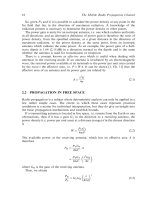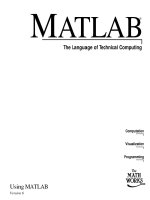The Mobile Radio Propagation Channel P1
Bạn đang xem bản rút gọn của tài liệu. Xem và tải ngay bản đầy đủ của tài liệu tại đây (407.22 KB, 30 trang )
The Mobile Radio Propagation Channel
The Mobile Radio Propagation Channel. Second Edition. J. D. Parsons
Copyright & 2000 John Wiley & Sons Ltd
Print ISBN 0-471-98857-X Online ISBN 0-470-84152-4
The Mobile Radio
Propagation Channel
Second Edition
J. D. Parsons,
DSc (Eng), FREng, FIEE
Emeritus Professor of Electrical Engineering
University of Liverpool, UK
JOHN WILEY & SONS LTD
Chichester ´ New York ´ Weinheim ´ Brisbane ´ Singapore ´ Toronto
The Mobile Radio Propagation Channel. Second Edition. J. D. Parsons
Copyright & 2000 John Wiley & Sons Ltd
Print ISBN 0-471-98857-X Online ISBN 0-470-84152-4
First Edition published in 1992 by Pentech Press
Copyright & 2000 by John Wiley & Sons, Ltd
Baf®ns Lane, Chichester,
West Sussex PO19 1UD, England
National 01243 779777
International (+44) 1243 779777
e-mail (for orders and customer service enquiries):
Visit our Home Page on: or
All Rights Reserved. No part of this publication may be reproduced, stored in a retrieval system, or transmitted, in any
form or by any means, electronic, mechanical, photocopying, recording, scanning or otherwise, except under the terms of
the Copyright, Designs and Patents Act 1988 or under the terms of a licence issued by the Copyright Licensing Agency,
90 Tottenham Court Road, London W1P 9HE, UK, without the permission in writing of the Publisher, with the
exception of any material supplied speci®cally for the purpose of being entered and executed on a computer system, for
exclusive use by the purchaser of the publication.
Neither the author(s) nor John Wiley & Sons Ltd accept any responsibility or liability for loss or damage occasioned to
any person or property through using the material, instructions, methods or ideas contained herein, or acting or
refraining from acting as a result of such use. The author(s) and Publisher expressly disclaim all implied warranties,
including merchantability of ®tness for any particular purpose.
Designations used by companies to distinguish their products are often claimed as trademarks. In all instances where
John Wiley & Sons is aware of a claim, the product names appear in initial capital or capital letters. Readers, however,
should contact the appropriate companies for more complete information regarding trademarks and registration.
Other Wiley Editorial Of®ces
John Wiley & Sons, Inc., 605 Third Avenue,
New York, NY 10158-0012, USA
WILEY-VCH Verlag GmbH,
Pappelallee 3, D-69469 Weinheim, Germany
Jacaranda Wiley Ltd, 33 Park Road, Milton,
Queensland 4064, Australia
John Wiley & Sons (Canada) Ltd, 22 Worcester Road,
Rexdale, Ontario M9W 1L1, Canada
John Wiley & Sons (Asia) Pte Ltd, 2 Clementi Loop #02-01,
Jin Xing Distripark, Singapore 129809
Library of Congress Cataloging-in-Publication Data
Parsons, J.D. (John David)
The mobile radio propagation channel/J.D. Parsons ± 2nd ed.
p. cm.
Includes bibliographical references and index.
ISBN 0-471-98857-X (alk. paper)
1. Mobile radio stations. 2. Radio ± Transmitters and transmission. 3. Radio wave
propagation. I. Title
TK6570.M6 P38 2000
621.3845 ± dc21 00-032482
British Library Cataloguing in Publication Data
A catalogue record for this book is available from the British Library
ISBN 0 471 98857 X
Typeset in 10/12pt Times by Dobbie Typesetting Limited, Devon
Printed and bound in Great Britain by Bookcraft (Bath) Ltd.
This book is printed on acid-free paper responsibly manufactured from sustaintable forestry,
in which at least two trees are planted for each one used for paper production.
The Mobile Radio Propagation Channel. Second Edition. J. D. Parsons
Copyright & 2000 John Wiley & Sons Ltd
Print ISBN 0-471-98857-X Online ISBN 0-470-84152-4
To my wife, Mary
and in memory of my parents
Doris and Oswald
The Mobile Radio Propagation Channel. Second Edition. J. D. Parsons
Copyright & 2000 John Wiley & Sons Ltd
Print ISBN 0-471-98857-X Online ISBN 0-470-84152-4
Contents
Preface . . ..................................................xv
Preface to the ®rst edition . .....................................xvii
1 Introduction . . . ...........................................1
1.1 Background . . .........................................1
1.2 Frequency bands . . .....................................4
1.2.1 VLF . ..........................................5
1.2.2 LF and MF ......................................5
1.2.3 HF . . ..........................................6
1.2.4 VHF and UHF . ..................................6
1.2.5SHF . ..........................................6
1.2.6 EHF . ..........................................7
1.3 Mobile radio frequencies . .................................8
1.3.1 Radio links ......................................9
1.3.2 Area coverage . . .................................10
1.4 Postscript ............................................13
References . ..........................................14
2 Fundamentals of VHF and UHF Propagation ......................15
2.1 Introduction . . ........................................15
2.2 Propagation in free space ................................16
2.3 Propagation over a re¯ecting surface ........................18
2.3.1 The re¯ection coecient of the Earth. . .................18
2.3.2 Propagation over a curved re¯ecting surface . .............21
2.3.3 Propagation over a plane re¯ecting surface. . .............22
2.4 Ground roughness . ....................................24
2.5The eect of the atmosphere . . ............................26
2.5.1 Atmospheric ducting and non-standard refraction . .........29
References . ..........................................31
3 Propagation over Irregular Terrain . . . ..........................32
3.1 Introduction . . ........................................32
3.2 Huygens' principle . ....................................33
3.3 Diraction over terrain obstacles . . . ........................34
The Mobile Radio Propagation Channel. Second Edition. J. D. Parsons
Copyright & 2000 John Wiley & Sons Ltd
Print ISBN 0-471-98857-X Online ISBN 0-470-84152-4
3.3.1 Fresnel-zone ellipsoids . ............................36
3.3.2 Diraction losses . ................................37
3.4 Diraction over real obstacles . . . . . ........................41
3.4.1 The uniform theory of diraction . ....................42
3.5Multiple knife-edge diraction . . . . . ........................46
3.5.1 Bullington's equivalent knife-edge . ....................47
3.5.2 The Epstein±Peterson method ........................47
3.5.3 The Japanese method . . ............................49
3.5.4 The Deygout method . . ............................50
3.5.5 Comparison . ....................................50
3.6 Path loss prediction models ...............................52
3.6.1 The Egli model . . ................................53
3.6.2 The JRC method . ................................54
3.6.3 The Blomquist±Ladell model. ........................56
3.6.4 The Longley±Rice models . . . ........................56
3.6.5CCIR methods. . . ................................60
3.6.6 Other methods . . . ................................62
3.7 Discussion ...........................................64
References . . .........................................68
4 Propagation in Built-up Areas .................................71
4.1 Introduction . . . .......................................71
4.2 Built-up areas: a classi®cation problem . . . ....................72
4.2.1 A classi®cation approach . . . ........................73
4.2.2 Classi®cation methods: a brief review. . . ................74
4.3 Propagation prediction techniques . . ........................77
4.3.1 Young's measurements . ............................77
4.3.2 Allsebrook's method. . . ............................79
4.3.3 The Okumura method . ............................81
4.3.4 The Ibrahim and Parsons method . ....................88
4.3.5The Wal®sch±Bertoni method ........................91
4.3.6 Other models ....................................95
4.4 Microcellular systems ..................................101
4.4.1 Microwave measurements . . . ....................... 102
4.4.2 UHF measurements . . . ........................... 105
4.4.3 Microcellular modelling ........................... 107
4.5Discussion ..........................................110
References . . ........................................111
5Characterisation of Multipath Phenomena . . . ....................114
5.1 Introduction . . . ......................................114
5.2 The nature of multipath propagation .......................116
5.3 Short-term fading . . . ..................................119
5.3.1 The scattering model . . ........................... 120
5.4 Angle of arrival and signal spectra . . .......................122
5.5 The received signal envelope . . . . . . .......................125
5.6 The received signal phase . ..............................127
viii Contents
5.7 Baseband power spectrum . . . ...........................128
5.8 LCRandAFD......................................130
5.9 The PDF of phase dierence . ...........................134
5.10 Random FM .......................................136
5.11 Rician fading .......................................139
5.12 Spatial correlation of ®eld components . . . . . ................140
5.12.1 Cross-correlation . . ............................ 142
5.13 The signal received at the base station . . . . . ................144
5.13.1 Vertically separated antennas . . .................... 146
5.13.2 Horizontally separated antennas.................... 147
5.14 The magnetic ®eld components...........................150
5.15 Signal variability . . ...................................152
5.15.1 Statistics of the fast fading........................ 153
5.15.2 Statistics of the local mean . . . .................... 155
5.15.3 Large area statistics. ............................ 155
References .........................................162
6 Wideband Channel Characterisation . . . .........................164
6.1 Introduction . . .......................................164
6.2 Frequency-selective fading ...............................165
6.2.1 Channel characterisation. . . ........................ 166
6.3 Characterisation of deterministic channels. . . . ................167
6.3.1 The time domain function. . ........................ 168
6.3.2 The frequency domain function . . .................... 169
6.3.3 The time-variant transfer function .................... 169
6.3.4 The delay/Doppler-spread function . . . ................ 170
6.3.5Relationships between system functions ................ 171
6.4 Randomly time-variant linear channels . . . . . . ................172
6.4.1 Channel correlation functions . . . .................... 172
6.4.2 Relationships between the functions. . . ................ 173
6.5Classi®cation of practical channels . . .......................174
6.5.1 The wide-sense stationary channel .................... 174
6.5.2 The uncorrelated scattering channel . . . ................ 175
6.5.3 The WSSUS channel . ............................ 177
6.6 Channel characterisation using the scattering function . . . ........178
6.6.1 The point scatterer description . . .................... 179
6.6.2 Statistical point scatterer model . . .................... 180
6.6.3 The scattering function ............................ 181
6.7 Mobile radio channel characterisation . . . . . . ................184
6.7.1 Small-scale channel characterisation. . . ................ 185
6.7.2 Large-scale channel characterisation. . . ................ 188
References . .........................................189
7 Other Mobile Radio Channels . . . .............................190
7.1 Introduction . . .......................................190
7.2 Radio propagation into buildings . . . .......................191
7.3 Propagation inside buildings . . ...........................195
Contents ix
7.3.1 Propagation characteristics . . ....................... 196
7.3.2 Wideband measurements........................... 199
7.4 Ray tracing: a deterministic approach.......................203
7.5Radio propagation in tunnels. . . . . . .......................210
7.6 Propagation in rural areas . ..............................211
7.6.1 Introduction ................................... 211
7.6.2 Signal statistics. . . ............................... 212
7.6.3 Small-scale signal variations: statistical modelling . . . . . .... 215
References . . ........................................218
8 Sounding, Sampling and Simulation............................221
8.1 Channel sounding . . ..................................221
8.2 Narrowband channel sounding . . . . .......................221
8.2.1 A practical narrowband channel sounder . . . ........... 223
8.3 Signal sampling......................................226
8.4 Sampled distributions . . . ..............................227
8.4.1 Sampling to obtain the local mean value . . . ........... 228
8.4.2 Sampling a Rayleigh-distributed variable . . . ........... 229
8.5Mean signal strength ..................................229
8.5.1 Con®dence interval . . . ........................... 230
8.6 Normalisation revisited . . ..............................232
8.7 Wideband channel sounding. . . . . . .......................233
8.8 Wideband sounding techniques. . . . .......................234
8.8.1 Periodic pulse sounding........................... 234
8.8.2 Pulse compression............................... 235
8.8.3 Convolution matched-®lter . ....................... 236
8.8.4 Swept time-delay cross-correlation ................... 237
8.9 System requirements ..................................239
8.9.1 Accuracy of frequency standards . ................... 241
8.9.2 Phase noise in signal sources ....................... 242
8.10 A practical sounder design ..............................242
8.10.1 Data processing ............................... 243
8.11 Experimental data processing . . . . . .......................246
8.11.1 Frequency domain characterisation. . . ............... 247
8.11.2 Large-scale characterisation ....................... 248
8.11.3 Summary . ................................... 248
8.12 Radio channel simulation ..............................248
8.12.1 Hardware simulation of narrowband channels . . . . . . .... 249
8.13 Wideband channels . ..................................253
8.13.1 Software simulation . ........................... 253
8.13.2 Hardware simulation. ........................... 257
References . ........................................261
9 Man-made Noise and Interference . ............................263
9.1 Introduction . . . ......................................263
9.2 Characterisation of pulses . ..............................265
9.2.1 Spectrum amplitude of a rectangular pulse . . . ........... 265
x Contents
9.2.2 Impulse generators . . . ............................ 267
9.3 Characterisation of impulsive noise . .......................267
9.3.1 Measurement parameters . . ........................ 267
9.4 Measuring equipment . . . ...............................270
9.4.1 Bandwidth . .................................... 273
9.4.2 Dynamic range. . ................................ 273
9.4.3 Receiver sensitivity and noise ®gure . . . ................ 274
9.4.4 Impulse response ................................ 274
9.5Practical measuring systems . . . ...........................275
9.5.1 Measurement of amplitude probability distribution ........ 276
9.5.2 Measurement of noise amplitude distribution ............ 278
9.6 Impulsive noise measurements . ...........................280
9.7 Discussion . . . .......................................286
9.8 Performance prediction techniques . . .......................287
9.8.1 Assessment of receiver performance using APD . . ........ 288
9.8.2 Assessment of receiver performance using NAD . . ........ 289
9.9 Interference . . .......................................295
9.9.1 Single interferer . ................................ 298
9.9.2 Multiple interferers. . . ............................ 299
References . .........................................304
10 Mitigation of Multipath Eects. . .............................307
10.1 Introduction .......................................307
10.2 Diversity reception . . . ...............................307
10.3 Basic diversity methods ...............................308
10.3.1 Selection diversity . ............................ 311
10.3.2 Maximal ratio combining........................ 312
10.3.3 Equal-gain combining . . ........................ 313
10.4 Improvements from diversity ...........................315
10.4.1 Envelope probability distributions. . ................ 315
10.4.2 LCR and AFD . . . ............................ 317
10.4.3 Random FM ................................ 320
10.5Switched diversity ...................................321
10.6 The eect of diversity on data systems . . . . ................322
10.7 Practical diversity systems . . ...........................325
10.8 Post-detection diversity ...............................325
10.8.1 Uni®ed analysis. . . ............................ 328
10.9 Time diversity . . . ...................................328
10.10 Diversity on hand-portable equipment. . . . . ................330
10.11 Discussion and conclusions . ...........................335
10.12 Interleaving. .......................................335
10.13 Channel equalisation . . ...............................337
10.13.1 Adaptive equalisers . . . ........................ 337
10.14 Non-linear equalisers . . ...............................338
10.14.1 Decision feedback equalisers. .................... 339
10.14.2 MLSE Viterbi equaliser ........................ 339
10.15Channel coding . . ...................................341
Contents xi
10.15.1 Linear block codes. ........................... 342
10.15.2 Convolutional codes . . . ....................... 344
10.16 Codes for fading channels . . . . . . .......................344
10.16.1 Performance of codes in fading channels . ........... 345
10.17 Speech coding ......................................347
10.17.1 Sub-band coders . . ........................... 347
10.17.2 Pulse-excited coders ........................... 348
10.18 The RAKE receiver ..................................348
10.19 Smart antennas . . . ..................................350
10.19.1 Considerations and possibilities................... 351
10.20 Wideband modulation: the alternative . . ...................355
10.20.1 Mitigation bandwidth . . ....................... 356
References. ........................................359
11 Planning Radio Networks . . ................................362
11.1 Introduction . . ......................................362
11.2 Cellular systems . . . ..................................363
11.2.1 Interference considerations. ....................... 366
11.3 Radio coverage ......................................369
11.3.1 Coverage of a small area . . ....................... 369
11.3.2 Coverage area of a base station . ................... 371
11.4 Planning tools. ......................................373
11.4.1 Self-regulating networks . . ....................... 379
11.5A modelling and survey analysis module . ...................379
11.5.1 Data preparation . . . ........................... 380
11.5.2 Model calibration . . . ........................... 380
11.5.3 Developing a model . ........................... 382
11.5.4 Limits on coecients. ........................... 384
11.5.5 Microcell model ............................... 384
11.6 Grade of service . . . ..................................384
11.6.1 Milli-erlangs per subscriber ....................... 385
11.7 Summary and review ..................................386
11.7.1 Cell site dimensioning ........................... 386
11.7.2 Base station site planning . ....................... 388
11.7.3 Frequency planning. . ........................... 388
11.7.4 Outputs of planning . ........................... 392
11.7.5Conclusion ................................... 392
11.8 A design example . . ..................................392
11.9 The future . . . ......................................395
11.9.1 A UMTS planning tool . . . ....................... 396
11.9.2 Ray tracing models . . ........................... 399
References . ........................................401
Appendices ................................................403
A Rayleigh Graph Paper and Receiver Noise Figure. . . . . .............403
B Rayleigh Distribution (dB) and CNR in a Rayleigh Fading Environment . 405
xii Contents
C Deriving PDFs for Variables in Logarithmic Units .................407
D Eective Signal Envelope . . .................................411
Index . . . .................................................413
Contents xiii
Preface
Some time ago it became apparent that the ®rst edition of this book was rapidly
approaching its sell-by date, since many aspects needed revision. There were two
obvious courses of action: to forget the whole thing and concentrate my energies on
other pursuits such as golf or ®shing, or to embark on a new edition. For several
reasons I was persuaded that a new edition was a worthwhile endeavour;many
people had made complimentary remarks or written complimentary letters about the
®rst edition and I understood that it had become a recommended text for several
postgraduate courses. The independent reviewers who had been contacted by the
publisher were also very kind;they were unanimous in their opinion that the
structure of the book should remain unchanged and that its appeal might be
jeopardised by attempting to make it much more system oriented. This is not to say,
of course, that there was no need for updating and the inclusion of some new
material. This was very much in line with my own thinking, so I was happy to accept
that advice. And so, work began.
Soon after I started, it became obvious that major scrutiny, rather than minor
attention, was needed. Of course there were some sections covering basic and well-
established theory which only needed small amendments, but I have revisited every
paragraph of the original book to correct errors, to improve the explanation and to
provide further clari®cation. In most of the chapters I have updated parts that were
in need of such action and I have added several new sections, particularly in Chapter
4. A section on ray tracing has been added to Chapter 7, and in Chapter 8 I have
extensively revised the sections describing practical channel sounders. The emphasis
in Chapter 9 has changed;I have considerably shortened the sections on man-made
noise measurements and I have extended the sections on how to predict system
performance in the presence of man-made noise. At one stage I was tempted to be far
more ruthless in cutting this chapter, since noise is not the limiting factor in cellular
radio systems, but in the end I decided to stick to my original theme and not be
constrained by considerations of one type of system, important though it may be.
The really major change, however, is the addition of two new chapters at the end
of the book. I realised that throughout the ®rst edition I had emphasised the way
multipath in¯uences system performance yet I had not described how to mitigate its
deleterious eects. Chapter 10 is an attempt to correct that omission, without
straying too far from the main theme and getting very system-speci®c. Again, having
The Mobile Radio Propagation Channel. Second Edition. J. D. Parsons
Copyright & 2000 John Wiley & Sons Ltd
Print ISBN 0-471-98857-X Online ISBN 0-470-84152-4









